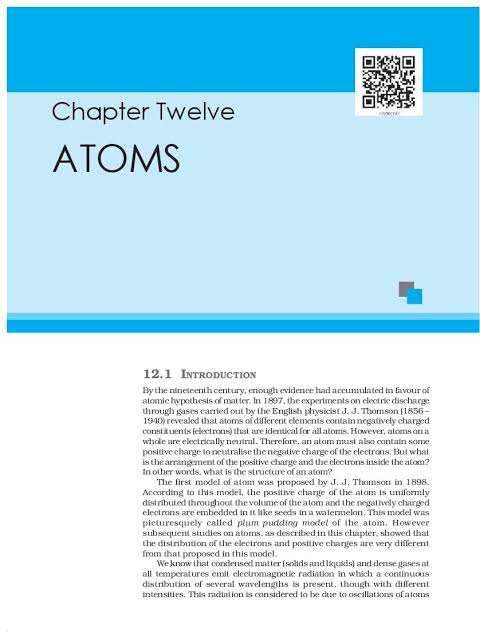Summary
Chapter 12, titled “Atoms,” in Class 12 Physics focuses on understanding the structure of atoms, one of the fundamental concepts in physics. The chapter delves into the historical background of atomic models, beginning with J.J. Thomson’s plum pudding model and progressing to more refined models like Rutherford’s nuclear model and Bohr’s model of the hydrogen atom.

Class 12 Physics Chapter 12 Atoms Book 📚 download in PDF format 👇👇
Rutherford’s gold foil experiment plays a crucial role in this chapter, as it established the concept of a small, dense nucleus at the center of the atom, with electrons orbiting around it. However, Rutherford’s model had its limitations, as it couldn’t explain the stability of atoms. This led to the development of Bohr’s model, which introduced the idea of quantized energy levels. According to Bohr, electrons move in specific orbits with fixed energy, and they emit or absorb energy only when they transition between these levels. Bohr’s model successfully explained the spectral lines of hydrogen but had limitations when it came to more complex atoms.
The chapter also covers the concept of energy levels and spectra, explaining how light emitted from atoms is quantized and can be used to identify elements. It discusses the dual nature of light and matter, wave-particle duality, and the concept of the de Broglie wavelength. The chapter concludes with a brief overview of the limitations of classical physics and the necessity of quantum mechanics in explaining atomic structure.
Overall, Chapter 12 provides a comprehensive understanding of atomic structure, preparing students for more advanced topics in quantum mechanics and atomic physics.
Short Answer Questions
What was J.J. Thomson’s atomic model?
Thomson’s atomic model, also known as the plum pudding model, proposed that an atom consists of a uniform sphere of positive charge with negatively charged electrons embedded in it like plums in a pudding.
Explain the main observation of Rutherford’s gold foil experiment.
Rutherford’s experiment showed that most alpha particles passed through the foil, but some were deflected at large angles, indicating a small, dense, positively charged nucleus at the center of the atom.
What is the significance of Bohr’s atomic model?
Bohr’s model introduced the concept of quantized energy levels, explaining the stability of atoms and the spectral lines of hydrogen.Define the term ‘atomic number.’The atomic number is the number of protons in the nucleus of an atom, which determines the chemical properties of an element and its position in the periodic table.
What are energy levels in an atom?
Energy levels are discrete orbits around the nucleus where electrons can exist without radiating energy. Electrons can move between these levels by absorbing or emitting photons.
What is a spectral line?
A spectral line is a distinct line of color in a spectrum, corresponding to a specific wavelength of light emitted or absorbed by an atom’s electrons as they transition between energy levels.How did Bohr’s model explain the stability of the atom?Bohr proposed that electrons orbit the nucleus in fixed energy levels without emitting radiation, thus maintaining the atom’s stability.
What is the de Broglie hypothesis?
The de Broglie hypothesis suggests that particles such as electrons have wave-like properties, with a wavelength inversely proportional to their momentum.
What is meant by wave-particle duality?
Wave-particle duality refers to the concept that particles like electrons exhibit both wave-like and particle-like properties, depending on the experimental conditions.
What limitations did Rutherford’s model have?
Rutherford’s model could not explain the stability of atoms, as it predicted that orbiting electrons would spiral into the nucleus due to energy loss from radiation.
What is the photoelectric effect?
The photoelectric effect is the emission of electrons from a material when it is exposed to light of a certain frequency, demonstrating the particle nature of light.Explain the term ‘quantization of energy levels.’Quantization of energy levels means that electrons in an atom can only occupy specific, discrete energy states, not intermediate ones.
What is the significance of Planck’s constant?
HuPlanck’s constant is a fundamental constant that relates the energy of a photon to its frequency, playing a crucial role in quantum mechanics.
What did Bohr postulate about electron orbits?
Bohr postulated that electrons revolve around the nucleus in fixed orbits with quantized angular momentum and do not emit radiation while in these orbits.
How are emission spectra formed?
Emission spectra are formed when electrons in an excited atom fall back to lower energy levels, emitting light of specific wavelengths.
What is an absorption spectrum?
An absorption spectrum is formed when atoms absorb light at specific wavelengths, causing electrons to jump to higher energy levels.
What is the Rydberg formula?
The Rydberg formula is an equation used to predict the wavelengths of spectral lines in hydrogen-like atoms, based on the energy levels of electrons.Define ionization energy.Ionization energy is the minimum energy required to remove an electron from an atom in its ground state.
What are isotopes?
Isotopes are atoms of the same element that have different numbers of neutrons but the same number of protons.
What is the difference between an atom’s ground state and an excited state?
The ground state of an atom is its lowest energy state, while an excited state occurs when one or more electrons have absorbed energy and moved to a higher energy level.
Long Answer Questions
Describe Rutherford’s gold foil experiment and its conclusions.
In Rutherford’s gold foil experiment, alpha particles were directed at a thin sheet of gold foil. Most particles passed through, but some were deflected at large angles, indicating that atoms have a small, dense, positively charged nucleus surrounded by mostly empty space. This experiment disproved the plum pudding model and led to the nuclear model of the atom.
Explain Bohr’s postulates and how they account for the hydrogen atom’s spectral lines.
Bohr’s postulates include the idea that electrons orbit the nucleus in fixed energy levels without emitting radiation. When an electron jumps between levels, it absorbs or emits a photon of energy equal to the difference between the levels. This explained the hydrogen atom’s spectral lines, where each line corresponds to a transition between energy levels.
Discuss the concept of energy quantization in atoms.
Energy quantization in atoms means that electrons can only occupy specific energy levels. The energy difference between these levels is quantized, meaning electrons can only gain or lose energy in discrete amounts. This concept is crucial for understanding atomic stability and the emission and absorption of light.
What are the limitations of Bohr’s atomic model?
While Bohr’s model successfully explained the hydrogen atom, it had limitations. It couldn’t accurately predict spectra for more complex atoms, and it didn’t account for electron-electron interactions or the relativistic effects seen in heavier elements. The model also failed to explain the fine structure of spectral lines.
Explain the dual nature of matter and its implications for atomic structure.
The dual nature of matter, as described by the de Broglie hypothesis, suggests that particles like electrons exhibit both wave-like and particle-like properties. This duality is crucial for understanding atomic structure, as it explains why electrons occupy specific energy levels and how they form stable orbits around the nucleus.
Describe the concept of the electron cloud in modern atomic theory.
In modern atomic theory, the electron cloud represents the probability distribution of an electron around the nucleus. Unlike Bohr’s fixed orbits, the electron cloud model suggests that electrons are found in regions of space where they are most likely to be located, known as orbitals. This model incorporates quantum mechanics and better explains the behavior of electrons in atoms.
How did the quantum mechanical model improve upon Bohr’s model?
The quantum mechanical model, based on Schrödinger’s wave equation, improved upon Bohr’s model by treating electrons as wave functions rather than particles in fixed orbits. It provided a more accurate description of electron behavior and allowed for the prediction of chemical properties and the formation of chemical bonds.
Discuss the significance of the uncertainty principle in understanding atomic structure.
The uncertainty principle, introduced by Heisenberg, states that it is impossible to simultaneously know both the exact position and momentum of an electron. This principle is significant in understanding atomic structure because it implies that electrons do not have precise orbits but exist in a probabilistic cloud around the nucleus.
Explain the role of the Pauli exclusion principle in the arrangement of electrons in atoms.
The Pauli exclusion principle states that no two electrons in an atom can have the same set of quantum numbers. This principle is crucial in determining the arrangement of electrons in atoms, as it explains why electrons fill orbitals in a specific order and how this arrangement leads to the formation of different elements.
How does the concept of electron configuration relate to the periodic table?
Electron configuration refers to the arrangement of electrons in an atom’s orbitals. The periodic table is organized based on electron configurations, with elements in the same group having similar configurations and chemical properties. Understanding electron configuration helps explain trends in the periodic table, such as atomic size, ionization energy, and electronegativity.

Get involved!
Comments